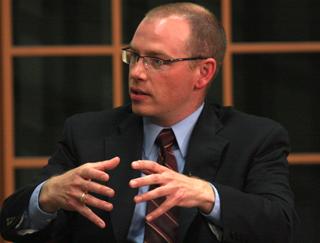Panel discusses natural disasters
“Issues and Attitudes: Nuclear Energy,” hosted and moderated by journalism professor Janice Collins, presented the risks and concerns Illinoisans may have about future disasters. The panel addressed whether or not Illinoisans are prepared and how the state can prevent these disasters from occurring.
“The earthquake in Japan has reminded us all that disaster can strike us anytime and in many ways we can hardly imagine,” Collins said.
She said four of the 10 nuclear plants in Illinois are active, and these four plants are similar to the design of Yukushima, the nuclear power plant in Japan.
The nuclear power plant closest to Charleston does not have this design.
Steven Daniels, the chairman of the physics department, said that humans constantly get radiation from the soil and the cosmic rays.
“It has some damage to cells almost no matter what so the question is ‘How much can you take?'” Daniels said.
Daniels said while the waste of the nuclear plant may be dangerous to a person in the direct area, by the time it gets around the world it would be diluted enough and become low radiation.
Jonathon Munken, the director of Illinois Emergency Management Agency, said Iodine 131 has been identified to be ten percent gama, which humans should be concerned with. “We take samples on a regular basis, whether there is a disaster globally or not,” Munken said. “We’ve detected more than 2,000 below the level at which there would be any amount of concern. As an isotope, it has a life of eight days so it will go away fairly quickly.”
Cameron Craig, a professor of geology, said once the radiation gets into the atmosphere it is carried through the air and over time its disperses and falls from the sky.
Munken said there are many things that are capable of threatening the state of Illinois, including the Wabash Valley Fault Line and the New Madrid Fault Line, which are close to Charleston.
“For the past two and half years, Munken said they have been working on a bill to prepare for a disaster.
“We’re participating a 7.7 magnitude earthquake on the New Madrid Fault,” Munken said.
Illinois is coming up to the 200th anniversary of the major earthquake on the New Madrid fault.
Every six months, each of the nuclear plants are tested for emergencies so they are in the position to be prepared for any emergency.
“Each time an earthquake goes up a number it is a factor of 10 times stronger,” Daniels said.
Munken said each of the plants in Illinois were designed to sustain the threats that are most significant.
“Earthquakes are one, but floods are another issue. There’s a plant in the Quad Cities right along the Mississippi River,” Munken said. “Tornados are also an issue.”
Fire Chief Pat Goodwin, from the Charleston Fire Department, said the city of Charleston and Coles County trains for the unknown the best they can.
“Charleston and Mattoon fire fighters have the technical rescue teams and also the HAZMAT team,” Goodwin said.
Goodwin said there are radiation detectors in all the vehicles throughout the fire and police departments.
“We can call in resources from four states,” Goodwin said. “They can deploy those resources and have them here within a few hours.”
Jennifer Brown can be reached at 581-2812 or jebrown2@eiu.edu.
Panel discusses natural disasters

Cameron Craig, a professor in the geology department at Eastern, discusses how radiation travels at the Issues and Attitudes: A Town Hall Meeting hosted by WEIU-TV Monday evening in the Buzzard Hall Auditorium. During the event, Craig discussed the role t





































































